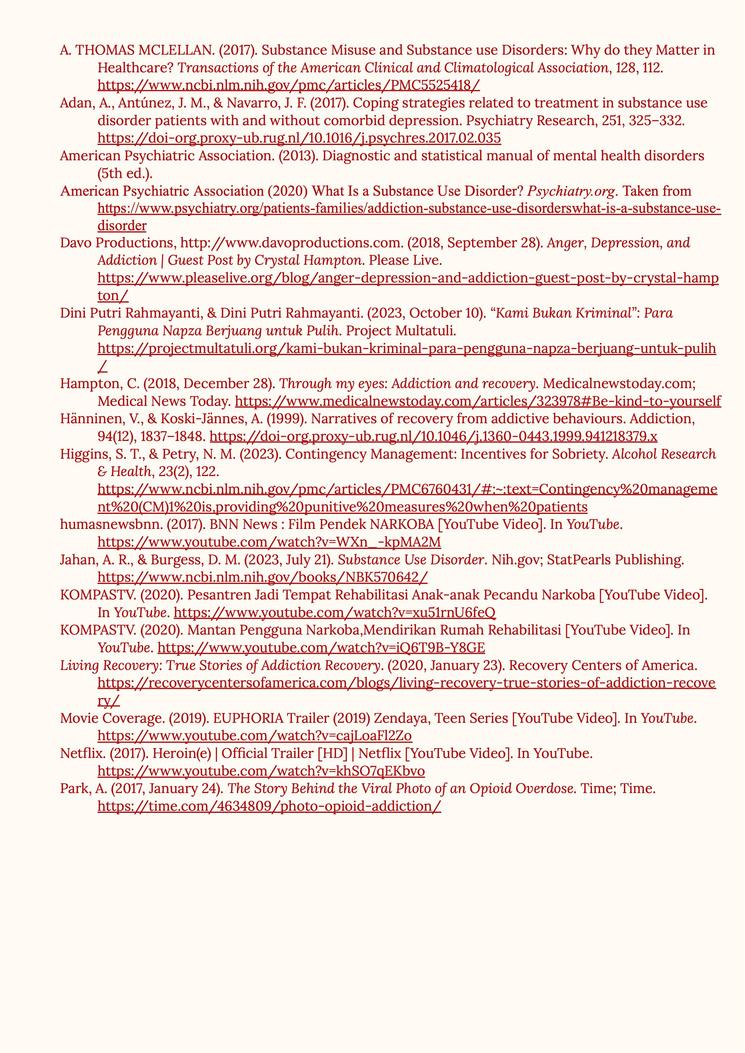







Nadya Marvella


Raden Roro Zahra
Shabrina Arinka
Silmy Diniya
Sophie Friedrich
Thalia Tamahagana










MEN TALDISORDER COURSE



01-15
16-26 Summary

Symptoms; Causes; Treatments Challenges; Coping Mechanisms
27-29
Screening; Diagnosis
Lived Experiences


The American Psychiatric Association (2020) defines substance use disorder (SUD) as a condition that involves uncontrolled substance usage despite detrimental consequences. People suffering from this condition are fixated on using a specific substance, like alcohol, tobacco, and illegal drugs, to the extent that the consumption results in a functional impairment. Usage is continued despite being aware that it will cause problems for the consumer. Substance use disorder entails symptoms including compulsive drug or alcohol use, tolerance, and withdrawal. It results from a mix of genetic, environmental, and psychological factors.

Substance use disorders (SUD) involve an excessive use of illicit substances that leads to impairment on the quality of the victim's life (Jahan et al., 2023).

According to APA, prolonged abuse of substances changes in the brain structure and function. Brain imaging studies show changes in areas of the brain that relates to memory, judgement, decision making, and behavioural control. These changes causes intensive cravings, changes in personality, and behaviour. Different types of substances can subject the person with SUD to varying effects on their body.
Withdrawal with excessive alcohol abuse can result in depression, irritability, insomnia, decline, and psychosis. Withdrawal with opioids can result in nausea, vomiting, excess sweating, and insomnia. The class of drug effects the symptoms as well as the withdrawal effects.

According to the DSM-5, the symptoms associated with substance use disorder fall into four major categories, namely, impaired control, social Impairment, risky use, and pharmacological.
Consuming the substance in larger amounts and for a longer amount of time than intended.
Persistent desire to cut down or regulate the use of the substance(s).
Spending much time obtaining, using, or recovering from the effects of substance use.
Experiencing cravings for the substance.
Substance use impairs the ability to fulfil major obligations at work, school, or home.
Continued use of the substance despite it causing significant social or interpersonal problems.
Reduction or discontinuation of recreational, social, or occupational activities because of substance use.

Recurrent substance use in physically unsafe environments. Persistent substance use despite knowledge that it may cause or exacerbate physical or psychological problems.
Tolerance: Individual requires increasingly higher doses of the substance to achieve the desired effect, or the usual dose has a reduced effect; individuals may build tolerance to specific symptoms at different rates.
Withdrawal: A collection of signs and symptoms that occurs when blood and tissue levels of the substance decrease. Individuals are likely to seek the substance to relieve symptoms. No documented withdrawal symptoms from hallucinogens, PCP, or inhalants.
Note: Individuals can have an SUD with prescription medications, so tolerance and withdrawal (criteria 10 and 11) in the context of appropriate medical treatment do not count as criteria for an SUD.

The cause of substance use disorders is multifactorial and includes psychological, biological, socio-cultural, and environmental factors (Jahan & Burgess, 2023). Some common contributing factors include:
genetic and family history environmental factors psychological factors social and peer pressure neurobiological factors

Drug addiction is more common in some families and likely involves an increased risk based on genes. If you have a blood relative, such as a parent or sibling, with alcohol or drug addiction, you're at greater risk of developing a drug addiction.
NIDA describes this component, offering that “scientists estimate that genetic factors account for between 40% and 60 % of a person’s vulnerability to addiction; this includes the effects of environmental factors on the function and expression of a person’s genes.” A person’s genetic makeup may either slow down or increase the extent to which they are vulnerable to developing dependence on a certain substance; also genetics may make a person more susceptible to one substance over another.
Significant environmental risk factors for both substance misuse and disorders include easy access to inexpensive alcohol and other substances, heavy advertising of these products, particularly to youth, low parental monitoring, and high levels of family conflict. In Indonesia, the influence of drug advertisements on television also has a reasonably strong impact on students’ decisions to buy drugs, with a percentage of 40% (Mufarrihah Mufarrihah et al., 2023). Environmental protective factors include the availability of healthy recreational and social activities and regular supportive monitoring by parents (McLellan, 2017).

A person’s support system or lack thereof can be a component in a person’s risk factor for developing substance use disorder. Those contending with a difficult family situation, such as abuse or neglect, may be more apt to use drugs, either within the time frame these behaviours are occurring or after, as a means to counter the negative emotions that linger. They may also use drugs as a means to seek attention that they are not otherwise receiving, or as a way to cry for help.
Comorbid psychiatric disorders have been associated with an increased risk of illicit substance use. For example, those with attention deficit hyperactivity disorder (ADHD) and bipolar affective disorders have an increased risk of developing a substance use disorder in adulthood compared to the general population (Jahan & Burgess, 2023).



The majority of drugs induce a feeling of pleasure or euphoria followed by other effects that vary depending on the drug. A person may use a drug to mask emotions such as unhappiness or loneliness. As they continue to avoid the root of these feelings and use, the drug replaces them with a false sense of well-being that increases their risk of developing a substance use disorder problem.


PCertain drugs may support, enhance, or alter cognitive or physical performance. For this reason, some people may consume them to aid in these processes. As their life exerts pressure on them to perform, focus, stay awake, or maintain a cheerful disposition, a person may begin to rely on the drug to counter these demands.
A person might experiment with drugs to bolster their social standing or to satisfy their curiosity after having witnessed their friends partaking. This holds particular concern for the adolescent and teenage populations. It is most worrisome for this age group because they are statistically proven to participate more frequently in at-risk behaviours. They may do this in order to gain approval from their peers or present this behavior as a symbol of independence or selfreliance (Rehab Center, 2016) .

Certain drugs such as cocaine, heroin, and painkillers have the capacity to form addictions quickly. This is not to say that those who don’t, can become abused or addicted; quite the contrary. Many individuals do not feel the effects as quickly or intensely, hence, it is common that they will use the drug more often or in larger amounts thus increasing their risk for substance use disorder.
A person’s body and mind can begin to build a tolerance against a drug. When this happens, a person will find that they are not experiencing the feeling that they desire; thus they often increase the amount of drug they are using to achieve this feeling, in turn increasing their risk for dependence (Rehab Center, 2016).
A person’s age, or rather the point at which drug use starts within their developmental process may also influence a drug’s potential for risk and dependence. NIDA says that the earlier that drug use begins, the more likely it will progress to more serious abuse (NIDA, 2018). This is because, at a certain age, young people are more apt to engage in risky behaviours because their brains have not yet fully developed the areas responsible for self-control, impulsivity, decision-making, and judgement, paired with hormonal imbalances and often times a weak sense of self-confidence, this can put a young person in a dangerous position .

Essentially, this means that a person’s gender may affect how a drug affects them (such as tolerance), while also playing a role in other factors that may influence the risk and prevalence of substance use disorder.
A fair amount of research suggests that gender can play a role in the risk for developing substance use disorder (NIDA, 2022). An article in Psychiatric Times cites that “there is now recognition that biologic and psychosocial differences between men and women influence the prevalence, presentation, comorbidity, and treatment of substance use disorders.”
2


Substance use disorder comes in many forms, including the type of substances, and each substance might have a different kind of treatment to be truly effective (Jahan et al., 2023).

Currently, the only substances with FDAapproved medication treatments are nicotine, alcohol, and opioids (Jahan et al., 2023).
Nicotine: Bupropion, varenicline, and nicotine replacement therapy.
Bupropion: Helps with nicotine cravings and withdrawal symptoms. Varenicline: Reduces withdrawal symptoms and blocks nicotine binding, decreasing the urge to use nicotine.
Nicotine replacement therapy (NRT): Helps with cravings and withdrawal symptoms.
Alcohol: Acamprosate, naltrexone, and disulfiram.
Acamprosate: Aids in reducing withdrawal symptoms.
Naltrexone: Reduces cravings and aids in preventing relapse.
Disulfiram: Produces unpleasant reactions to alcohol consumption to prevent further consumption.
Note: In a clinical setting, it is important to include vitamin B1, vitamin B9, and multivitamins, in order to address any nutritional deficiencies.

Opioids: Methadone, naltrexone, buprenorphine-naloxone, and clonidine. Methadone can only be used to treat opioid use disorder by specific treatment facilities, Opioid Treatment Programs (OTPs).
Buprenorphine-naloxone has less potential for overdose.
During opioid withdrawal, clonidine may help reduce the severity of withdrawal symptoms and stabilize blood pressure.
Also referred to as "detox," is the first stage of treating drug dependence and aims to manage withdrawal symptoms while users stop using addictive substances safely. It occurs when the patient stops using the drug(s) and allows the body to rid itself of them. The substance or an alternative may be tapered off to decrease the effects of withdrawal.


An extensive approach to treating SUDs, combining counselling and behavioural therapies with FDA-approved drugs, treatment programs, harm reduction, and long-term support in order to increase treatment retention, decrease drug use, minimize the risk of overdose, and improve overall quality of life.


For stimulants, like cocaine and amphetamine, there are no approved pharmacological treatments yet. However, nonpharmacological therapy involves operant conditioning reinforcement in the form of contingency management.
Contingency management is a strategy used in alcohol and other drug (AOD) abuse treatment to encourage positive behavior change (e.g., abstinence) in patients. This is done by providing positive reinforcing consequences when patients meet treatment goals and withholding those consequences or providing punitive measures when patients engage in undesired behavior (e.g., drinking) (Higgins & Petry, 2023). For example, when patients perform abstinence, the positive consequences may include receipt of vouchers that are exchangeable for retail goods, whereas negative consequences for drinking may include withholding of vouchers or an unfavorable report to a parole officer.
To conclude, due to a lack of pharmacological treatments, a nonpharmacological approach such as operant conditioning reinforcement in the form of contingency management, can be used as an alternative treatment.
16



Addiction & Withdrawal: One of the hallmarks of SUD is the physical dependence on the substance. Discontinuation leads to withdrawal symptoms, which can be severe, painful, and, in some cases, life-threatening.
Long-term Health Complications: Chronic substance use can lead to diseases like liver cirrhosis (alcohol), lung diseases (smoking), or cardiovascular diseases (stimulants).
Many individuals with SUD also struggle with other mental health disorders such as depression, anxiety, or PTSD. This dual diagnosis can make treatment more complex. Moreover, substance use can exacerbate the symptoms of these mental health conditions, creating a vicious cycle.



Reference for analysis: Project M

People with SUD often face societal stigma. They may be labelled as "addicts" or "junkies" and seen as morally weak or as failures. This stigma can lead to social isolation, where friends and family distance themselves, either due to prejudice or the challenging behaviours associated with addiction.
Maintaining a substance habit can be expensive, leading to financial difficulties. Job loss or difficulty in finding employment due to substance use can further strain finances.
Many substances are illegal, and possession can lead to incarceration. Engaging in illegal activities to finance their addiction, such as theft, can further entangle individuals with the justice system.
Discrimination in employment, housing, and other areas is not uncommon for those with a history of substance use disorder. Policies that prioritize punishment over rehabilitation can make reintegration into society more challenging.


Reference for analysis: Euphoria series

Reference for analysis: Time.com
Reference for analysis: Heroin(e) documentary
Substance use disorder can strain relationships with loved ones due to erratic or violent behaviours, neglect of responsibilities, or other negative impacts. Breakdown of trust is common as individuals may lie about their use or actions related to obtaining the substance.
Denial is a significant challenge. Many do not see their substance use as a problem or believe they can quit whenever they want. Lack of access to quality treatment, especially in underserved areas, can hinder recovery. Cost is another barrier; not everyone can afford treatment or lacks adequate insurance coverage.
SUD is a chronic condition, and relapse is a common part of the recovery journey. Relapses can be demoralizing and lead to feelings of guilt and hopelessness. The environment can play a role, as returning to the same environment or associating with the same peers can trigger relapse.
Feelings of guilt, shame, and low self-worth are common among those with SUD.
Coping mechanisms can be defined as “cognitive and behavioural efforts aimed to manage the internal and external demands of a person or environment” (Adan et al., 2017). What kind of coping strategies an individual engages in can greatly impact the development, course, and treatment outcomes of substance use disorder (SUD).
Coping strategies are necessary for being able to manage cravings for the abused substance, for enabling a person to avoid relapse, and lastly, for maintaining sobriety and recovery.
e c a n d i f f e r e n t i a t e b e t w e e n t w o t y p e s o f c o p i n g s t r a t e g i e s :


Unfortunately, there are also harmful coping styles people with substance use disorder adopt. For individuals with SUD, it could mean that they cope by consuming more of the substance, a behaviour called “escalation”.
Ahmed (2010) found that the escalation behaviour of different types of drugs, meaning the increasingly heavy use of a substance, can be increased by heightened drug availability. If a drug is made more accessible, this will accordingly increase the usage of the drug.

Source: HumansNewsBNN (YouTube)
Other examples include individuals like Crystal Hampton, who had been suffering from substance use disorder and allegedly got out of her addiction on a path of prayer and meditation. She stresses how self-love and self-acceptance played an important part in overcoming her substance use disorder.

Man ping mec
The Reco who have Gina, who rtant to he
Reco aim of h their sobr mily, men hich inclu were also ming her a

Most personal accounts share similar stories with regard to their substance use disorder recovery. Improvements to their conditions were made by getting medical or professional help from doctors or by joining a sobriety programme. The importance of family and having a good social support system was also emphasised by many. The following paragraphs show examples of such narratives.

Hänninen & Koski-Jännes (1999), after applying narrative analysis techniques to the written testimonies of recovered alcoholics, bulimics, smokers, and sex and gambling addicts in Finland, discovered that they could extract 5 dominant narratives from these testimonies, namely, the Alcoholics Anonymous (AA) story, the personal growth story, the codependence story, the love story, and the mastery story. These five dominant narratives show that there can be patterns found in the way individuals lay them out. For example, the Alcoholics Anonymous (AA) dominant story includes the phenomena of ‘hitting rock bottom’, which is then followed by the coping mechanism of finding professional help, yet only by joining Alcoholics Anonymous a drastic improvement to their situation could be made (Hänninen & Koski-Jännes, 1999).





Screening for substance use disorder (SUD) in low-resource settings like Indonesia can be challenging However, it is crucial to identify people who may require help and support Therefore, there is an urgent need to identify strategies as a means to overcome this challenge. One of the available options is using screening tools listed below:
a. Screening to Brief Intervention (S2BI)


b. Brief Screener for Tobacco, Alcohol, and other Drugs (BSTAD)
c. Alcohol, Smoking, and Substance Involvement Screening Test (ASSIST)
d. Alcohol Use Disorders Identification Test (AUDIT)
e. Drug Abuse Screening Test (DAST-10)

(National Institute on Drug Abuse, 2019).
These screening tools are great options as they have been scientifically validated, such as DAST-10 which have been proven as reliable (Yudko et al., 2007), easy to administer using electronic devices (can be self-administered as well), and provide questions that do not heavily rely on cultural settings, therefore are applicable in different cultural circumstances. Additionally, there could be improvements made such as providing translation using local languages and more culturally sensitive matters (if necessary) to ensure better understanding and results.

A thorough evaluation carried out by a licensed healthcare practitioner is required for the diagnosis of substance use disorder (SUD). It seeks to identify if a person satisfies the requirements for a substance use disorder and, if so, to rate the disorder's severity. A single test cannot identify substance use disorder. Instead, healthcare professionals base their decisions on an in-depth analysis of your health history and substance use practices.
In addition to reviewing reports from prescription drug monitoring programs, they may order drug testing. The American Psychiatric Association's Diagnostic and Statistical Manual of Mental Disorders (DSM-5) is used to guide the evaluation's diagnostic criteria.

A few challenges in diagnosing and treating SUD low-resource settings are the limited access to healthcare, lack of mental health worker, a shortage of trained professionals, as well as stigma.
Training is necessary to improve and ensure the quality of the treatments. This allows healthcare workers to enhance their skill be it the basic medical/psychological skills, specialized training for emergencies, incorporating technologies, etc. to improve the treatments provided.
Collaboration between healthcare professionals across different fields
Interdisciplinary collaboration among professionals can be an option to mitigate problems as it fosters and encourages competency and readiness of healthcare workers in working with people with SUD, since physiological comorbidities may exist and the interventions are not limited to psychotherapy.
Strategies (not limited for treatments) should be enhanced by and done simultaneously with developing research. People who have authorities in the research & development field should collaborate and invest in research to further gain understanding about the cultural context for other workers to provide a more specific psychological prevention & intervention methods suitable and appropriate for the people.

In Indonesia, incorporating cultural background in treating individuals with Substance Use Disorder (SUD) is paramount for many strategic reasons. Firstly, cultural values, beliefs, and practices play a significant role in influencing an individual's perception of substance use, recovery, and therapeutic interventions. Approaches misaligned with a patient's cultural background can reduce engagement, misunderstandings, and resistance to treatment. For instance, religious influences play a crucial role in therapeutic interventions; it is expected to incorporate prayers, religious leaders, and religious teachings in the recovery process for example, the presence of an Islamic school as a rehabilitation shelter in Jember, Indonesia.
Secondly, culture shapes coping mechanisms, support systems, and the pathways through which individuals seek help. As a collectivist country, culture shapes how Indonesians manage such as referring to traditional rituals, religious practices, or group support instead of professional support. A culturally insensitive approach might overlook or undermine these crucial support mechanisms. Understanding these nuances ensures that treatment is not only practical but also holistic, respectful, and tailored to meet the individual's unique needs. In essence, to achieve long-lasting recovery and foster trust, it's strategically imperative to weave in the cultural tapestry of individuals undergoing treatment for SUD.
Jember, Indonesia



Realstoriesfromyoungpeopleinrecovery.(n.d.).RecoveryBuildAPG. https://www.recoverybuild.org/real-stories-from-young-people-in-recovery/ U.S.DepartmentofHealthandHumanServices.(2019,May30).Screeningtoolsforadolescentsubstance use.NationalInstitutesofHealth.https://nida.nih.gov/nidamed-medical-healthprofessionals/screening-tools-resources/screening-tools-adolescent-substance-use Yudko,E.,Lozhkina,O.,&Fouts,A.(2007).Acomprehensivereviewofthepsychometricpropertiesofthedrug abusescreeningtest JournalofSubstanceAbuseTreatment,32(2),189–198 https://doi.org/10.1016/j.jsat.2006.08.002
